THE GROWING PROBLEM OF MOLD - Connecticut State ...
THE GROWING PROBLEM OF MOLD - Connecticut State ...
THE GROWING PROBLEM OF MOLD - Connecticut State ...
Create successful ePaper yourself
Turn your PDF publications into a flip-book with our unique Google optimized e-Paper software.
44 <strong>MOLD</strong> (cont'd.)<br />
ment complex are seeking approximately<br />
$180 million from Glenwood<br />
Management Corporation and the<br />
complex operator, East 77 th Realty<br />
LLC, for injuries and personal property<br />
damage allegedly caused by mold<br />
exposure while they were living in the<br />
complex. The complaint revolves<br />
around the fact that the defendants<br />
knew of the mold but did nothing to<br />
remediate the situation and failed to<br />
notify tenants.<br />
Homeowners associations have<br />
also been sued. In one case, three<br />
families filed suit alleging that toxic<br />
mold caused a variety of ailments.<br />
The case was eventually settled for<br />
$550,000.<br />
In 1999, an Ohio builder was forced<br />
to sell all of his company’s assets because<br />
of the cost of remediating mold<br />
damage caused by excessive moisture<br />
in new homes. The situation was discovered<br />
when homeowners began to<br />
complain of wet carpeting. Then mold<br />
was discovered on the subfloor.<br />
Finally, holes were cut in the drywall<br />
to inspect the framing and a quarter<br />
of an inch of standing water was discovered<br />
in the bottom of the stud cavities.<br />
At first it was thought that poor<br />
detailing of the brick veneer was the<br />
cause, but this was proven not to be<br />
the case. The actual source of the water<br />
in the wall of the new homes was<br />
exterior vapor. The vapor entered<br />
through the sheathing and condensed<br />
on the back of the polyethylene<br />
under the drywall because of the<br />
cooled inside air. To fix the moisture<br />
problem in hundreds of homes would<br />
result in a cost of $50,000 to $70,000<br />
per home. The company did not have<br />
the assets to correct the situation.<br />
Not only are insurance companies,<br />
property management firms and contractors<br />
being sued over mold issues,<br />
but, in some cases, a property’s previous<br />
owners are also being sued.<br />
Owners of a house in California filed<br />
suit against the seller of the house.<br />
The case was settled for a little over<br />
$1.25 million.<br />
School districts are also being sued<br />
by students, parents and staff members<br />
for alleged injuries caused by<br />
molds. In DuPage County, Illinois,<br />
1,700 students, parents and teachers<br />
have filed a suit alleging that the<br />
school district was negligent for not<br />
properly remediating the school after<br />
a flood that precipitated mold growth.<br />
Litigation involving mold infestation<br />
causing property damage and<br />
bodily injury has been or is being adjudicated<br />
in such jurisdictions as<br />
California, Delaware, Florida, Illinois,<br />
New York, Ohio and Texas. While<br />
these and many other cases are currently<br />
on court dockets, toxic mold injury<br />
claims still face evidentiary and<br />
causation issues. There have been no<br />
standards issued as to what is an acceptable<br />
quantity of mold and what<br />
quantity is harmful to people. There<br />
must also be a determination made as<br />
to the type of mold, since so few molds<br />
are actually capable of producing<br />
“toxic” mycotoxins. With no guidelines<br />
as to “how much exposure is too<br />
much” or until health issues caused<br />
or aggravated by mold are proven, lawyers<br />
are looking for issues involving<br />
professional malpractice, such as construction<br />
defects. Other issues involve<br />
workers’ compensation, fraud and<br />
failure to disclose problems at the time<br />
of sale of the property, indoor air quality<br />
and sick building syndrome issues,<br />
and negligence on the part of architects,<br />
plumbers, and roofers for defective<br />
design or workmanship.<br />
WHY NOW?<br />
Many believe that the energy crisis of<br />
the 1970s and the desire to construct<br />
The Code Official, May/June 2002 • BOCA International, Inc.
















